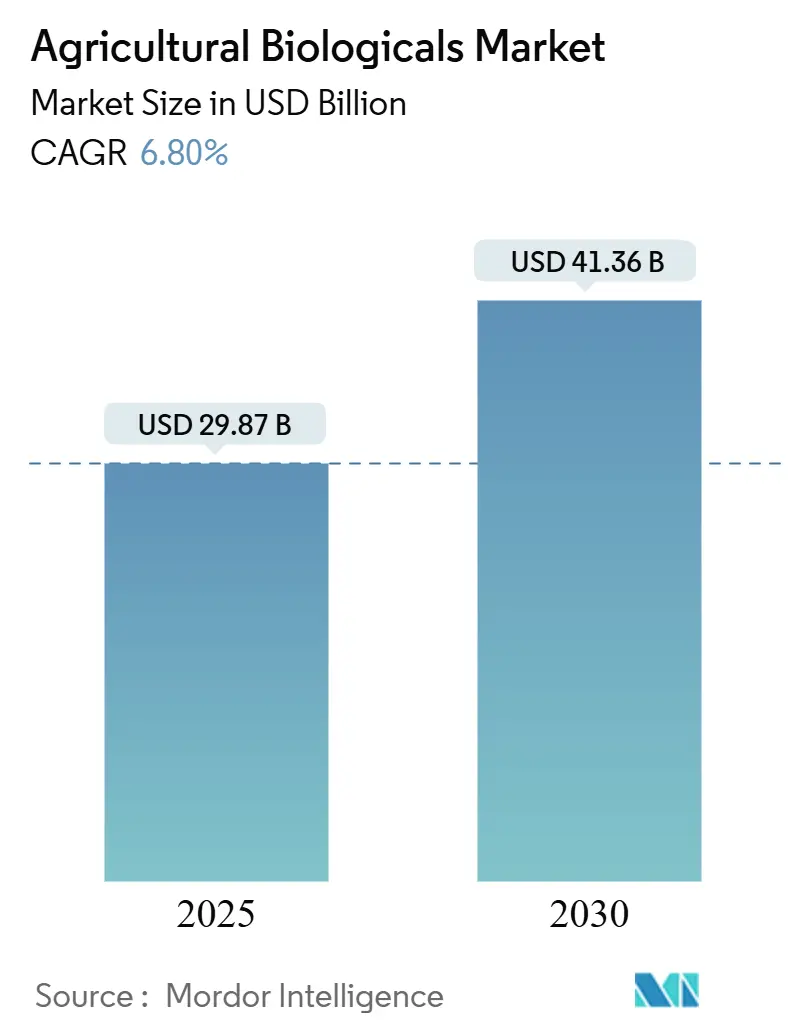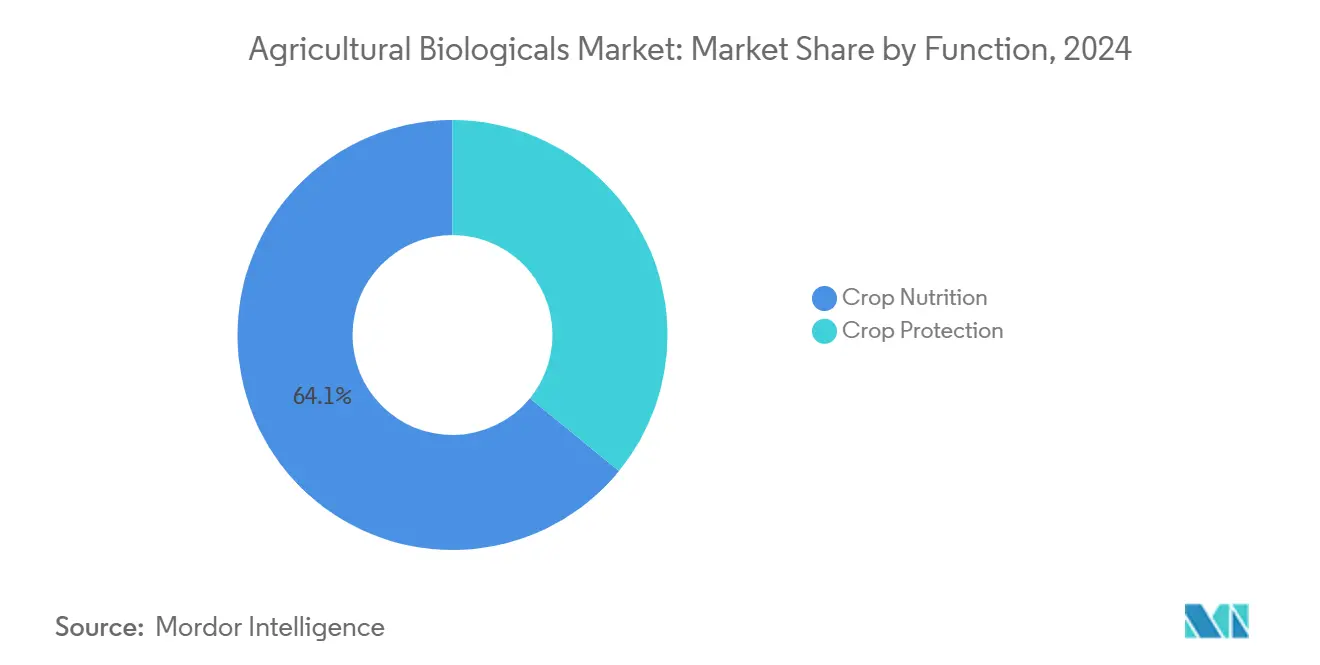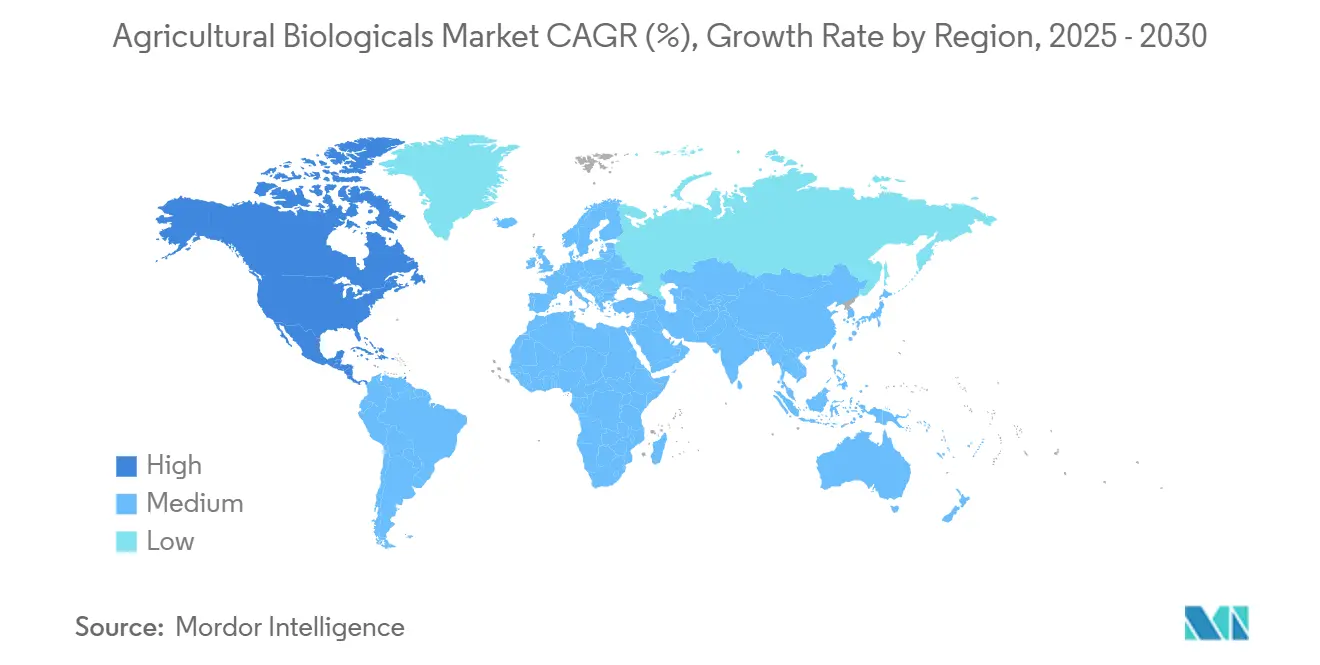Agricultural Biologicals Market Size and Share

Agricultural Biologicals Market Analysis by Mordor Intelligence
The agricultural biologicals market size stood at USD 29.87 billion in 2025 and is projected to advance at a 6.8% CAGR to reach USD 41.36 billion by 2030, underscoring the sector’s steady structural shift toward sustainable crop inputs. Escalating regulatory scrutiny of synthetic residues, farmer demand for soil health solutions, and the acceleration of artificial intelligence–enabled strain discovery collectively propel growth. Large food retailers are tightening residue standards, widening the addressable base beyond certified‐organic farms. Rapid microbial research and development (R&D) cycles now deliver commercial candidates in months instead of years, compressing time-to-market and intensifying competitive churn. Corporate capital commitments to local manufacturing and on-farm fermentation lower logistics costs and widen geographic reach.
Key Report Takeaways
- By function, crop nutrition led the agricultural biologicals market with a 64.1% share in 2024 and is forecast to post the fastest CAGR of 6.8% through 2030.
- By crop type, row crops accounted for 75.4% of the agricultural biologicals market size in 2024. Horticultural crops are projected to expand at a 7.1% CAGR to 2030.
- By geography, Europe held a 34.3% regional share in 2024, while North America is projected to advance at an 8.8% CAGR to 2030.
- The top five players, including Corteva Agriscience, Koppert Biological Systems B.V., Biofirst Group NV, Valent BioSciences LLC, and Syngenta AG, hold a limited share in the agricultural biologicals market.
Global Agricultural Biologicals Market Trends and Insights
Drivers Impact Analysis
| Driver | (~) % Impact on CAGR Forecast | Geographic Relevance | Impact Timeline |
|---|---|---|---|
| Rising demand for organic, residue-free produce | +1.8% | Global, strongest in North America and Europe | Medium term (2-4 years) |
| Stringent global curbs on synthetic agrochemicals | +1.5% | Europe and North America, growing in the Asia Pacific | Long term (≥ 4 years) |
| Integration of biologicals into corporate IPM programs | +1.2% | Global, led by North and South America | Medium term (2-4 years) |
| Carbon-credit revenue from regenerative practices | +0.9% | North America and Europe, and emerging in Australia | Long term (≥ 4 years) |
| AI-enabled microbial-strain discovery | +0.7% | Developed markets worldwide | Short term (≤ 2 years) |
| On-farm fermentation and local bio-input manufacturing models | +0.6% | Asia-Pacific and Africa, spreading to South America | Medium term (2-4 years) |
| Source: Mordor Intelligence | |||
Rising Demand for Organic, Residue-Free Produce
Organic food sales in the United States rose 4.6% to USD 67.2 billion in 2024, reflecting shoppers’ heightened vigilance over pesticide residues. Premium pricing for certified produce incentivizes conventional growers to adopt biological inputs that help them clear stringent retailer tests. Similar patterns unfold in expanding middle-income segments of Asia, where food safety ranks high among household concerns. As supermarkets tighten private residue standards, biological solutions move from optional to compulsory within many supply contracts. The pull effect boosts recurring demand across biofertilizer, biostimulant, and biopesticide categories.
Stringent Global Curbs on Synthetic Agro-Chemicals
The European Union has banned more than 70 active ingredients since 2020 under its Farm to Fork Strategy, whereas the United States Environmental Protection Agency allows fast-track registration for eligible microbial pesticides[1]Source: European Commission, “Farm to Fork Strategy,” ec.europa.eu . Tighter maximum residue limits shorten the commercial life of many synthetic products. Farmers now face fewer chemical options, raising the strategic value of biological substitutes that clear regulatory hurdles in roughly 18 months, half the timeline of conventional actives. Policymakers’ alignment on risk-reduction amplifies the long-run demand floor for biologicals.
Integration of Biologicals into Corporate IPM Programs
Agribusiness majors embed microbial inoculants and biocontrol agents within integrated pest management packages, simplifying adoption for time-pressed growers. Corteva’s USD 300 million Symborg acquisition enriched its nitrogen-fixing and phosphorus-solubilizing portfolio. Multinationals leverage existing agronomy teams and channel relationships to cross-sell biologicals alongside synthetic crop protection, driving faster penetration of mainstream row-crop acreage. For growers, complementary programs minimize performance risk while easing compliance with evolving residue mandates.
Carbon-Credit Revenue from Regenerative Farming Practices
The USDA allocated USD 3.1 billion in 2024 to its Partnership for Climate-Smart Commodities, rewarding practices that sequester carbon through microbial soil amendments[2]Source: United States Department of Agriculture, “USDA Announces New Partnerships to Advance Climate-Smart Agriculture,” usda.gov. Voluntary markets price credits above USD 15 per metric ton of CO₂ equivalent, turning bio-based soil enhancers into revenue-generating assets. Verification protocols such as Verra’s VM0042 specify biological inputs as eligible practices, enabling growers to monetize adoption. The revenue upside strengthens the business case for biologicals beyond agronomic yield gains.
Restraints Impact Analysis
| Restraint | (~) % Impact on CAGR Forecast | Geographic Relevance | Impact Timeline |
|---|---|---|---|
| Short shelf life and cold-chain dependence of many formulations | –1.1% | Global, acute in tropical regions | Short term (≤ 2 years) |
| Complex, non-harmonized registration pathways | –0.8% | Global, toughest in emerging markets | Long term (≥ 4 years) |
| Proliferation of counterfeit and sub-standard biologicals | –0.6% | Asia-Pacific and Africa, growing in South America | Medium term (2-4 years) |
| Volatile supply of critical feedstocks such as seaweed | –0.4% | Global, critical for biostimulant makers | Short term (≤ 2 years) |
| Source: Mordor Intelligence | |||
Short Shelf Life and Cold-Chain Dependence Of Many Formulations
Many live-culture formulations require storage between 2 °C and 8 °C, which can increase distribution costs by up to 40% where refrigerated trucking is limited[3]Source: Cold Chain Federation, “Cold Chain Logistics for Agricultural Biologicals,” coldchainfederation.org.uk. Heat exposure during last-mile delivery can significantly reduce viable colony counts and compromise field performance, eroding farmer confidence. Tropical markets in Southeast Asia and sub-Saharan Africa experience the highest spoilage rates, which constrain volume growth unless shelf-stable formulations scale rapidly.
Complex, Non-Harmonized Registration Pathways
Obtaining approval for a single biological active remains a country-by-country process that lacks mutual recognition, compelling firms to prepare separate toxicology, efficacy, and environmental dossiers for every jurisdiction. These duplicative requirements can push combined registration costs above USD 2 million and extend timelines to more than three years, which disproportionately burdens small and mid-size innovators. Differing residue definitions often force additional crop trials or reformulations so products can satisfy local maximum residue limits, adding another growing season of delay. In many emerging markets, regulators still rely on data templates designed for synthetic chemicals, leading to requests for tests that are irrelevant for live microbes and inflating compliance budgets. The absence of harmonized standards therefore, staggers product launches across regions, leaving growers without timely access to newer, safer biological tools and slowing the global scaling of sustainable practices.
Segment Analysis
By Function: Nutrition Keeps Lead as Biopesticides Accelerate
Crop nutrition maintained a commanding 64.1% share of the agricultural biologicals market in 2024 as growers prioritized soil microbiome resilience and nutrient-use efficiency. The segment’s leadership reflects tangible cost savings from reduced synthetic fertilizer demand and improved carbon-credit earnings. Within this category, biofertilizers that fix nitrogen deliver up to 50 pounds per acre equivalence, directly lowering input purchases. Biostimulants extend benefits by enhancing abiotic stress tolerance, a valued trait amid widening climate variability.
Crop nutrition is growing at a robust pace, outpacing all other functions with a 6.8% CAGR. In addition, the maturity of crop nutrition ensures continued volume dominance. However, portfolio diversification into combined nutrition-protection products is rising as manufacturers pursue cross-functional value propositions.
Beyond volume metrics, innovation intensity differentiates players. AI-guided strain selection now underpins next-generation inoculants that deliver precise metabolite profiles, cutting trial-and-error costs while elevating field consistency. Nutrient formulations are increasingly integrating carrier chemistries that shield microbes from UV radiation and desiccation, extending shelf life to 18 months without refrigeration.

By Crop Type: Row Crops Dominate, Horticulture Rises
Row crops accounted for 75.4% of agricultural biologicals applications in 2024, led by corn and soybean systems, where scale economics magnify the return on investment. Volume adoption has been accelerated by corporate supply contracts demanding integrated pest management verification, effectively embedding biologicals within standard agronomic protocols. Nevertheless, horticultural crops are poised for the quickest ascent at a 7.1% CAGR through 2030. Premium fruit and vegetable segments reap higher price premiums for residue-free compliance, allowing quicker payback on biological inputs even at smaller acreage footprints. The agricultural biologicals market size for horticultural uses is projected to almost double by 2030 as retailers extend zero-tolerance residue policies.
Cash crops, such as cotton and sugarcane, continue to experience incremental uptake in response to herbicide resistance pressures and export market residue restrictions. Manufacturers are developing crop-specific microbial blends tailored to soil pH and pathogen spectra, thereby enhancing efficacy while reducing total chemical load. BASF’s seed-treatment suite targeting cotton demonstrated up to 20% yield gains in multi-location trials. Such targeted advances suggest share gains for companies that align strain libraries with crop physiology.
Geography Analysis
Europe held a 34.3% share of the agricultural biologicals market in 2024, underpinned by the European Union’s combination of chemical bans and financial stimuli for organic transitions. Member states reimburse up to 25% of biological input costs within eco-scheme payments, shortening grower payback horizons. Despite its scale, expansion moderates as penetration nears 100% in high-value fruit sectors, prompting European suppliers to pivot outward and export regulatory expertise and formulations through technology partnerships.
North America registered the fastest 8.8% CAGR by 2030. The Coordinated Framework for Biotechnology simplifies microbial approvals to an 18-month median, catalyzing product pipeline throughput. Capital spending on domestic fermentation plants by Corteva and BASF exceeds USD 700 million, signaling a long-term commitment. Cross-border regulatory alignment with Canada further enlarges the contiguous addressable market, while Mexico’s export-oriented fruit sector adopts biologicals to meet European residue limits.
The Asia-Pacific region stands as the emerging frontier, driven by India’s expedited clearance of 15 biological pesticides in 2024 and China’s subsidy program, which rebates up to 30% of farmers' purchases. Investment in decentralized production hubs mitigates cold-chain gaps, making biologicals viable in tropical smallholder systems. Regional market growth also benefits from mounting consumer backlash against chemical overuse and soil contamination. South America sustains robust volume growth anchored in Brazil’s soybean dominance. Local fermentation capacity and Brazil’s IN 36 fast-track process reduce approval costs, catalyzing a surge in domestic and multinational launches tailored to Cerrado soils. Argentina and Chile accelerate adoption to preserve export competitiveness as European importers enforce tougher residue ceilings.

Competitive Landscape
The agricultural biologicals market remains highly fragmented, with the top supplier controlling less share of global revenues. Acquisition waves are underway as capital-rich multinationals seek scale and strain libraries. BASF’s USD 2.6 billion Nunhems takeover bolstered its vegetable seed treatments while adding broad microbial IP. Corteva’s Symborg deal exemplifies the strategy of integrating nitrogen-fixing capabilities into mainstream portfolios. Bayer’s EPA-cleared genetically modified Bacillus product signals a next technology leap that may redraw competitive boundaries.
Competitive dynamics coalesce around three archetypes. First, specialist pure-plays innovate niche solutions and often become acquisition targets. Second, traditional agrochemical giants deploy R&D depth and distribution muscle to widen addressable acreage. Third, synthetic biology and data science firms partner with formulators to monetize their proprietary platforms. Patent filings rose 35% in 2024 at the United States Patent and Trademark Office, with a focus on strain optimization and formulation stability themes, as reported on.
Scale advantages accrue to firms with integrated fermentation capacity and global regulatory teams that are adept at multi-jurisdictional filings. Yet small innovators can thrive through regional partnerships and exclusive licensing of hot-climate strains. Collaboration models between input suppliers and digital-ag platforms are emerging, bundling microbial solutions with precision application prescriptions. Overall pricing power remains tempered by abundant competition and farmer price sensitivity, maintaining a customer-friendly landscape.
Agricultural Biologicals Industry Leaders
-
Corteva AgriScience
-
Koppert Biological Systems B.V
-
Biofirst Group NV
-
Valent BioSciences LLC
-
Syngenta AG
- *Disclaimer: Major Players sorted in no particular order

Recent Industry Developments
- November 2025: Corteva announced Goltrevo, a new broad-spectrum, microbial-based insect control product. It is formulated from a novel strain of the entomopathogenic fungus Beauveria bassiana strain 203, originally isolated from palm weevil beetles.
- May 2025: Syngenta inaugurated a 22,000 m² biologicals facility in Orangeburg, SC, capable of producing 16,000 metric tons of biostimulants annually.
- May 2025: Syngenta has acquired Intrinsyx Bio, a California-based startup that develops products to improve crop nutrient use efficiency. This acquisition strengthens Syngenta's position in the growing biologicals market by providing it with Intrinsyx Bio's technology and pipeline, which includes products like the Nuello iN seed treatment.
Global Agricultural Biologicals Market Report Scope
The scope of the study includes a detailed analysis of the agricultural biologicals market, including biological control products, Biocontrol, Biofertilizers, Biostimulants, Organic Fertilizers, and Biopesticides. The report evaluates the market size, along with the market share and trends, of the agricultural biologicals market. The market operates at B2B and B2C levels, and the market sizing has been done at the consumer level.
| Crop Nutrition | Organic Fertilizers |
| Biofertilizers | |
| Biostimulants | |
| Crop Protection | Biopesticides |
| Biocontrol Agents |
| Row Crops |
| Horticultural Crops |
| Cash Crops |
| North America | United States |
| Canada | |
| Mexico | |
| Rest of North America | |
| South America | Brazil |
| Argentina | |
| Rest of South America | |
| Europe | Germany |
| United Kingdom | |
| France | |
| Spain | |
| Italy | |
| Netherlands | |
| Russia | |
| Turkey | |
| Rest of Europe | |
| Asia-Pacific | China |
| India | |
| Japan | |
| Australia | |
| Vietnam | |
| Thailand | |
| Indonesia | |
| Philippines | |
| Rest of Asia-Pacific | |
| Middle East | Iran |
| Saudi Arabia | |
| Rest of Middle East | |
| Africa | South Africa |
| Nigeria | |
| Egypt | |
| Rest of Africa |
| By Function | Crop Nutrition | Organic Fertilizers |
| Biofertilizers | ||
| Biostimulants | ||
| Crop Protection | Biopesticides | |
| Biocontrol Agents | ||
| By Crop Type | Row Crops | |
| Horticultural Crops | ||
| Cash Crops | ||
| By Geography | North America | United States |
| Canada | ||
| Mexico | ||
| Rest of North America | ||
| South America | Brazil | |
| Argentina | ||
| Rest of South America | ||
| Europe | Germany | |
| United Kingdom | ||
| France | ||
| Spain | ||
| Italy | ||
| Netherlands | ||
| Russia | ||
| Turkey | ||
| Rest of Europe | ||
| Asia-Pacific | China | |
| India | ||
| Japan | ||
| Australia | ||
| Vietnam | ||
| Thailand | ||
| Indonesia | ||
| Philippines | ||
| Rest of Asia-Pacific | ||
| Middle East | Iran | |
| Saudi Arabia | ||
| Rest of Middle East | ||
| Africa | South Africa | |
| Nigeria | ||
| Egypt | ||
| Rest of Africa | ||
Key Questions Answered in the Report
What is the current value of the agricultural biologicals market?
The agricultural biologicals market size reached USD 29.87 billion in 2025 and is projected to hit USD 41.36 billion by 2030.
Which segment leads agricultural biological adoption by function?
Crop nutrition dominates, holding 64.1% share of the agricultural biologicals market in 2024 due to its dual soil health and nutrient-efficiency benefits.
Which crop category uses biologicals the most?
Row crops such as corn and soybeans account for 75.4% of total applications, reflecting large-scale integrated pest management mandates.
Which region is growing the fastest for biological inputs?
North America is advancing at an 8.8% CAGR through 2030, driven by streamlined EPA registrations and new fermentation capacity investments.
What is driving investment in biological R&D?
Artificial intelligence enabled strain discovery cuts development time and cost, while carbon-credit revenue streams boost farmer demand, encouraging corporate R&D spending.
How fragmented is the competitive landscape?
The leading player controls less than 5% of global revenue, resulting in a market concentration score of 2 and ample room for consolidation.
Page last updated on:



